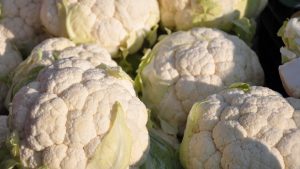How to Grow Cauliflower from Seed to Harvest
Cauliflower is one of the most important winter crops. This crop is mainly cultivated for its tender flowers. This crop known as ‘Poogobi’ is used in many different dishes. Cauliflower is rich in minerals like potassium, sodium, iron, phosphorus, calcium and magnesium.

Current Cultivation Problems:
- Cost of seeds is high
- Lack of technical knowledge of farmers
- Pest problems are high
- Excessive (indiscriminate) use of pesticides
- Lack of comprehensive management of fertilizers and pesticides
Short Term Varieties:
10 Grams of seeds Contains approximately 2000 seeds
Early Kuvvari: Released by Punjab University. Very early ripening variety. With light green leaves, the leaves have a smooth coating. The flowers are white, thick and delicate. It is harvested in the month of September
Pusa Katki: Harvested in the month of October-November. Published by I.A.R.I., New Delhi. The plant is medium in size with light green leaves and medium sized flowers.
Pusa Deepali: Released by New Delhi Agricultural Research Station. The variety has medium length, straight leaves, similar to those with rounded terminal parts. Vertical arrangement of leaves favors further planting. Flowers are white.
Mid Term Varieties:
Improved Japanese: This variety was introduced from Israel. The leaves are long, horizontal, vertical and the flowers are medium in size.
Pant Shubha: Released by Pant Nagar Agricultural University. The outer leaves of this variety are slightly vertical and the inner leaves densely cover the flower. The flower is slightly cone-shaped and white in color with a slight brown color.
Pusa Himajyoti: Released from the Katrine research station. The leaves of this species are vertical, blue-green in color and have a smooth coating on the leaves. The entire flower is completely covered with leaves. The flowers are white and do not lose their color even when exposed to the sunlight. This variety is especially suitable for cultivation in hilly areas.
Pusa Hybrid-2: A hybrid released by Agricultural Research Station, New Delhi. The plants are upright and erect with bluish-green leaves. This variety is resistant to powdery mildew. The flower is white and weighs about 970 g. It is harvested from mid-November to mid-December and gives a yield of 23 tonnes per acre.
Ooty No.1: It is released by Tamil Nadu Agricultural University, Ooty Research Centre. Perfect for hilly areas. It is harvested in 110-120 days and yields 46 tonnes per hectare. The flowers are equally large and attractive. It can be cultivated throughout the year in the hilly areas of southern region. Also suitable for seed production.
Long term verities:
Pusa Synthetic: Released by New Delhi Agricultural Research Centre. The leaves are straight and the flowers are medium in size, white and curved. Mid to late September is suitable for planting. It is harvested in January.
Pusa Shubha: A variety released by New Delhi Agricultural Research Centre. Plants are straight and have long stems. The leaves are blue-green in color. The flowers weigh 700-800 grams. After 90-95 days of planting, half of the cabbage are ready for harvesting. This variety is resistant to black rot.
Dania: Released from Kalimpong area. A variety that grows well in the eastern hilly areas. It is harvested in the months of January-February. The flowers are medium in size. This variety does not tolerate changes in climate.
Pusa Snowball: Released from the Katain research Centre. The leaves are vertical, stiff and cover the flower. The flowers are thick, medium and white. First half of October is suitable for cultivation in North Indian region. It is harvested in the months of January-February.
Pusa Snowball K-1: Launched from Katrine research Centre. Blackberry is a disease resistant variety. The leaves are staright the flowers are well covered. The flowers are white and round. This variety is very popular due to its late harvest and good quality. It is harvested in the months of January-February.
Weather:
Requires a cool climate. Mostly grown in winter. In cool mountainous areas, it gives good crop even in summer. A temperature of 15-20 celsius is most suitable for plant growth.
Soils:
Black alluvial soils with good drainage are suitable for cabbage cultivation. Soils with a Soil PH levels 5.5–6.5 are suitable.
Crop Season:
Rainy season: July-August
Winter season: September-November
Seeds per Acre:
40 sq.m. 280-320 seeds per acre can be soaked and planted.
240-320 g for short duration varieties.
160-200 gms for chronic varieties.
Sowing distance:
Short duration varieties 45×45 cm
Medium duration varieties 60×45 cm
Long duration varieties 60×60 cm
Water Management:
The growing stage of the flower should be identified as a critical stage. Depending on the nature of the soil i.e. once in 10 days in dark soils and once in 6 days in light soils. Water should be stopped before the flower is harvested.
Harvesting:

Harvesting should be done at regular intervals depending on the variety selected. Otherwise the cauliflower will get coated and the quality will be poor. Depending on the variety, the yield can be 10-20 tons.
Yield:
Average yield is 8.0 – 14.0 tones/acre depending on the season and variety.
